Project managers meet the project cost objective when the total amount money spent at the end of the project is under budget. Project budget is a big constraint since the project is authorized and it should only be changed using formal change control procedures.
To get the project finished under budget, we need to measure cost performance on each review date. Earned Value Management (EVM) is the ANSI 748 standard method to measure the project cost performance objectively. According to EVM standard, as of each status date, three measures are enough to analyze the project cost performance:
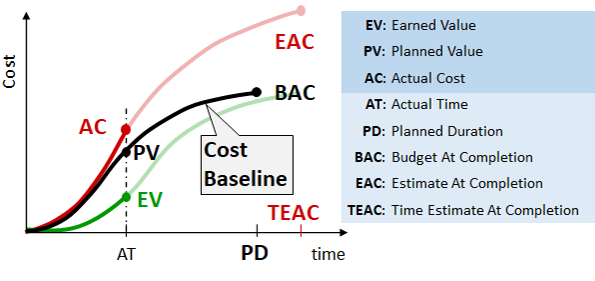
- Planned Value (PV) or Budgeted Cost of Work Scheduled (BCWS) is the authorized budget assigned to scheduled work, up to status date. At project or phase closing, PV equals Budget at Completion (BAC).
- Earned Value (EV) or Budgeted Cost of Work Performed (BCWP) is the measure of work performed expressed in terms of the budget authorized for that work, up to status date. At project or phase closing, EV equals Budget at Completion (BAC), so as the PV.
- Actual Cost (AC) or Actual Cost of Work Performed (ACWP) is the realized cost incurred for the work performed on an activity up to status date.
EVM provides two kinds of metrics: Lagging indicators to measure cumulated variations up to status date; and leading indicators to forecast final cost at project closing. This information helps steering committee make decisions and request preventive or corrective actions. Measure and adjust periodically is the key to finish the project on budget.
Let’s check a real example of a project with an initial budget of €750k. Project cost is controlled using only 3 work packages:

- Project Management (€125k): Budget for this work package is €125k, including €100k for project manager hours, and €25k for software and hardware purchases.
- Internal Work (€375k): 5 internal workers invoiced at a hourly rate of 40€/h (€200k), 2 contractors on time and materials at a hourly rate of 50 €/h (€100k), and 15 travels costing €5k each (€75k).
- Outsourced Work (€250k): A whole part of the project is under fix priced contract arranged with an external provider.
Let’s move to the review meeting after 80 days since the project was started. Work performance data shows this information regarding scope and schedule:

- Work packages 000 and 100 are completed by 50%. Outsourced work has not started.
- Work packages 000 and 100 have started on time. They are due as planned.
However, cost performance measures tell us that cost performance to date is not acceptable. These charts show the project cost performance after 80 days of execution:

In the middle of the project, checking cost performance data –Planned Value = €466.8k, Actual Cost = €333,6k and Earned Value= €233.4k– we can say that cost performance so far is not good:
- Cost Performance Index is 0.7. CPI = 233.4 / 333.6 = 0.7. This means that project is completing 70 cents per euro spent.
- However, according to To Complete Performance Index, every euro spent should complete €1.24 to finish on budget. TCPI = (750-233.4) / (750-333.6) = 1.24. In other words: cost performance should improve by a 77%!
- Currently we have an over cost of €100.2k. CV = 233.4-333.6 = -100.2.
- If we continue like this, we expect a final over cost of €322k. Estimate at Completion EAC=€1072k. EAC = 750/0.7 = 1072.
- Schedule Performance Index time SPI(t)=0.55, means that the project is progressing late. Schedule Variance time SV(t) tells us that we are delayed for 36 days.
This trend chart shows how over cost has evolved to reach €100.2k:
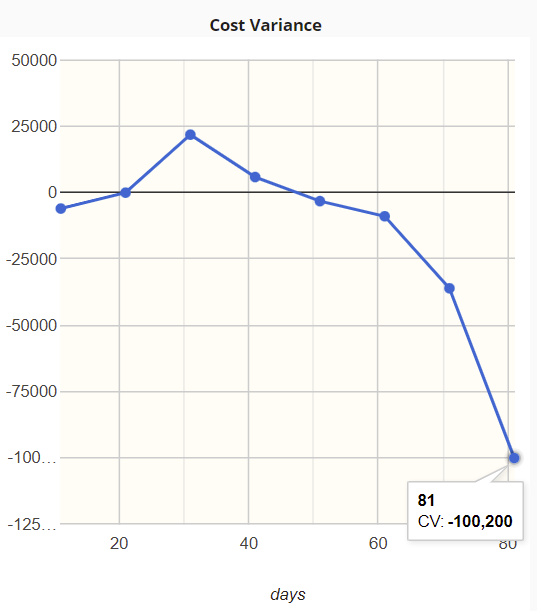
Schedule variance time has decreased up to 36 days of delay:

Root analysis found that client was asking for more requirements without accepting deliverables. Following the escalating process, a meeting was called to extend scope, schedule (+2 months) and cost (+€50k). Budget at Completion –BAC– was increased from €750k to €800k. Project cost was rebaselined:
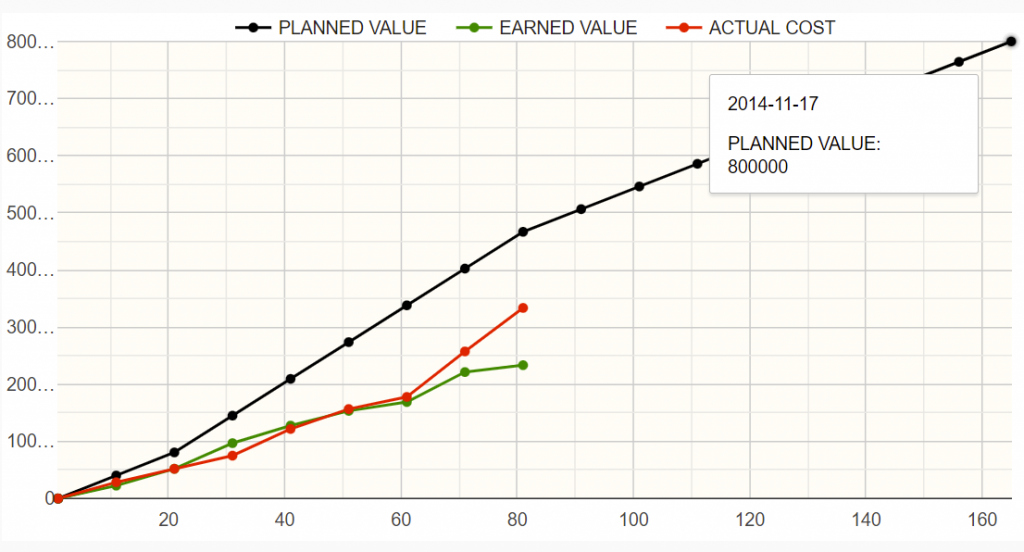
Finally, EVM charts show that the project finished with an over cost of €55K, very high for sure, but not so high as estimated in the previous report of €322k. In fact, charts show the positive change after rebaseline.
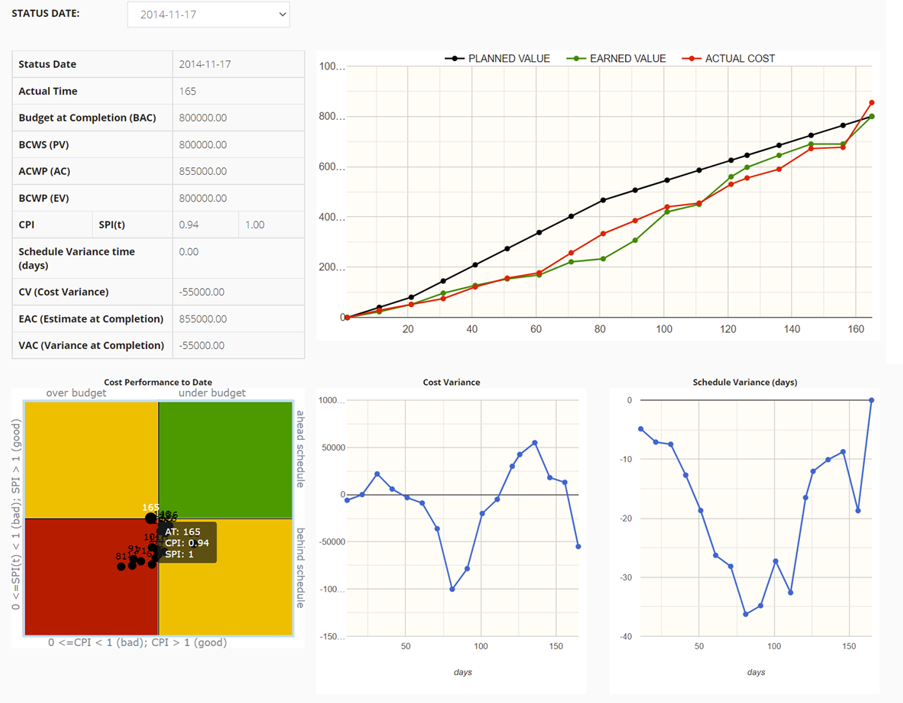
Professional project managers can control project performance effectively with PMPeople.
PMPeople is the tool for the project economy. It is aimed to unify professional project management by these differential points:
- Designed by and for professional project managers, following professional project management standards.
- Online productivity –less meetings, less documents, less workflows– through distributed collaboration among 12 specialized roles: Organization Owner, 6 roles on demand management and 5 roles on supply management.
- Freemium product –unlimited time, unlimited users– usable via web and mobile application.
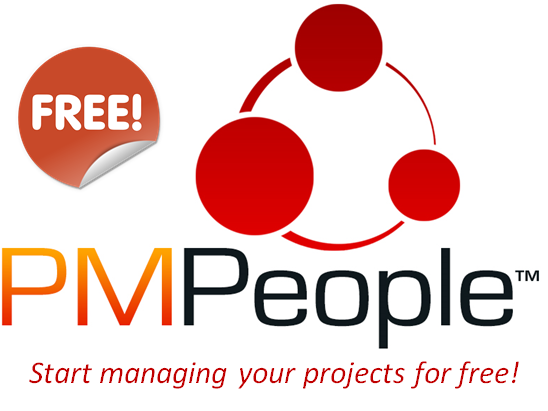
Start using PMPeople for free, for unlimited time and for any number of users. In premium organizations, only managers have a cost. Several roles –stakeholders, team members, sponsors and resource managers– are always free. You can increase or decrease your premium seats according to the organization actual needs. Premium organizations have access to our interactive support through Slack. Our servers are located in EU. This software can also be hosted on customer premises.
Jose Barato
Related posts
Categories
- Business (16)
- Demand Management Roles (14)
- Frequently Asked Questions (7)
- Guide (26)
- People (23)
- Assignments (2)
- Feedback (2)
- Project Team (3)
- Tracking Time And Expenses (2)
- Process (9)
- Closing (2)
- Executing And Controlling (2)
- Planning (1)
- Project Management (67)
- Management Frameworks (18)
- Organization Owner (OO) (3)
- Project Economy (54)
- Tools (19)
- Supply Management Roles (5)
- Training (6)
- Uncategorized (1)




